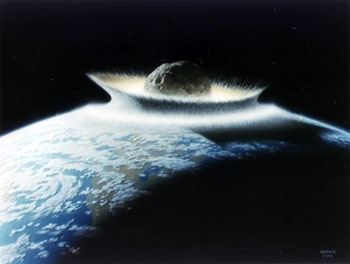When will science catch up with Hollywood? In our new Cinema Science series, running all this week, NOVA intern Samantha Johnson examines the real science of classic sci-fi tropes like time travel, super-suits, ray guns, and more. First up: Saving Earth from killer asteroids.
"It happened before. It will happen again. It's just a question of when," says an ominous voice in the opening sequence of the film "Armageddon," as we watch a deadly asteroid strike the earth, decimating the dinosaurs. But before you build an underground bunker and stock up on a lifetime supply of SpaghettiOs, let's take a minute to find out what films like "Armageddon" and "Deep Impact" get right-and wrong-about how to save the world from killer asteroids and comets.
 Image courtesy of NASA/Don Davis. Artist's concept of a catastrophic asteroid impact with the early Earth. |
Though they seem to slam into movie and TV screens every year, asteroids capable of exterminating entire species are exceedingly rare. There are many smaller Near-Earth Objects (NEOs), which, on average, hit the earth every 200 years and could potentially level a city. Earth's most recent brush with destruction came in 1908, when a 30- to 50-meter-wide object exploded over Siberia, destroying more than 800 square kilometers of forest, but, apparently, killing no one.
So, what can we do to save humanity from the Big One? Hollywood often opts for big explosions with the latest Aerosmith power ballad blaring in the background. The heroes blow up the killer rock at the last possible second and the camera pans across cheering crowds from New York to Mumbai watching the mass detonation. In "Deep Impact," astronauts destroy an incoming comet with nuclear weapons minutes before impact.
In "Armageddon," a crew of rugged oil drillers lands on the asteroid, digs 800 feet into the surface, and deploys nuclear weapons four hours before impact. This would supposedly break the asteroid into two pieces, which would somehow clear the Earth. While this method does give the filmmaker an excuse to put Bruce Willis in space, it doesn't bode well for humanity.
But in reality, most scientists agree that, even in the most desperate circumstances, blowing up a threatening asteroid would be a bad idea. If we try to blast the big scary rock, we'll most likely end up with many little scary rocks. They would rock our world with the same amount of kinetic energy, resulting in an equally devastating event.
In the real world, scientists would like to give the asteroid or comet a slight nudge--just enough to throw it off its crash course with Earth. Possible deflection strategies include attaching a giant solar sail to the asteroid to reflect radiation; painting it to reflect solar radiation; and using nuclear-powered robots to dig up and eject rock from the asteroid. All of these proposals are still in the conceptual stages.
These ideas would require great feats of engineering, stresses Dr. Donald Yeomans, manager of NASA's Near-Earth Object Office. But another method is within our technological grasp: hitting the asteroid with a massive object. The idea is not to destroy the NEO, but to tap it in another direction using an enormous payload. In 2005, the Deep Impact spacecraft collided with Comet Tempel 1, demonstrating that it is possible to accurately pinpoint and hit a rotating comet. This technique could be supplemented by other approaches, like placing an unmanned spacecraft nearby, allowing its gravity to pull the perilous rock off course.
But the best medicine is prevention, says Yeomans: "Find them early, find them early, find them early." Early detection is key for averting a killer impact, as most of these deflection strategies would take at least a few years to plan and execute.
Fortunately, there is a growing community of celestial watchdogs who track down and monitor these troublesome entities. NASA's Near-Earth Object Program Office at the Jet Propulsion Laboratory was established in 1998-- the same year that "Armageddon" and "Deep Impact" came out in theaters--to lead this effort. The program's original goal was to find at least 90 percent of the estimated 2,000 asteroids and comets that approach the Earth and are at least one kilometer wide. It has nearly accomplished that goal and is now focusing on finding 90 percent of objects as small as 140 meters wide by the year 2020.
A report on planetary defense recently released by NASA makes it clear that further research and more funding is needed for detecting asteroids and developing deflection strategies. Dr. Yeomans and most scientists agree that knocking it off course with explosives is our best bet for now, but it looks like we'll have decades--probably centuries--to perfect our plans. It also looks like the real-life heroes will be ground-based, as none of the many proposed strategies involve manned missions. Dr. Yeomans said, "My philosophy would be you want to do what's simplest." Director Michael Bay of "Armageddon" clearly had something else in mind.
Samantha Johnston is currently studying broadcast and print journalism at UCLA Extension. She has traveled through Greece, Ecuador and Peru studying anthropology and archaeology, and earned her BA from the University of California, Santa Barbara, in 2007. On clear, moonless nights, you'll find her stargazing on Southern California's Mount Pinos.



